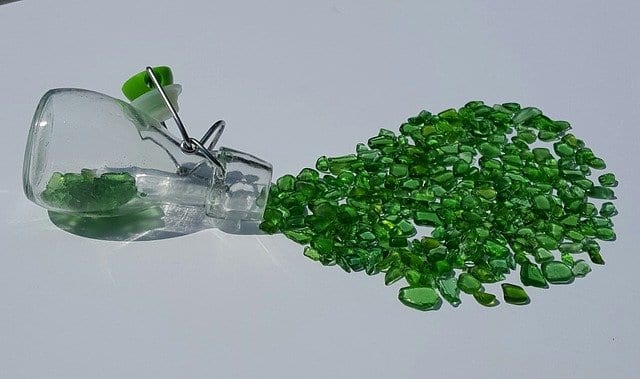The clouds had been building all afternoon. The smell of rain wafted through the muggy, July night. Each gust of wind rattled the windows. Moonlight no longer filtered through the multitude of colored glass bottles. Widow Rachel Ainsley’s glass bottle cottage had withstood many storms.
For as long as she could remember, she had collected uniquely shaped colored glass bottles. She was fascinated by the way they refracted light. She believed they stored her memories.
When she and Dwight Ainsley married and moved to Inwood, Indiana, she took her bottles with her. Dwight not only accepted her unique bottle collection, but he began saving bottles too.
Many years later after Dwight’s death in World War II, Rachel recalled that her neighbors regularly asked, “What are you going to do with all those bottles?”
“Why build a house, of course,” she replied emphatically.
“Glass is fragile. It will break with the first strong storm.”
“The thick glass in these bottles is sturdy enough, and the mortar will seal and hold them tight.” she explained confidently.
As she built her glass house with the help of a couple of Dwight’s army buddies, the community mocked her.
“You’re crazy. You belong in an asylum.”
These were the same people with whom she’d grown up in the small Midwest town. They were usually supportive and more critical of outsiders. However, Rachel’s free spirit and artistic talents weren’t appreciated by the home folks with their strong work ethic.
Nevertheless, she ignored them, although their harsh words scratched at her heart. As she selected and arranged each bottle, she recalled a memory. As a child, her grandmother insisted that she take a spoonful of castor oil from the amber apothecary bottle. The pale-yellow liquid was disgusting. “It’ll keep your bowels regular,” her grandmother reminded her.
A lovely, crescent decanter, containing her mother’s favorite perfume, Shalimar, graced her vanity now. “Just a dab, a little on your wrists and behind your ears,” her mother instructed.
Every fall she helped the women can apples, green beans, and whatever else the garden and orchard provided. They washed and sliced the fresh fruits and vegetables to fill the mason jars, and then submerged them in boiling water on the stove top. After the properly sealed jars had cooled, they stacked them in their pantries. Throughout the dreary winter, Rachel especially enjoyed eating the canned green beans seasoned with a little fat back.
The men used to gather on the porch and share their fishing and hunting exploits while drinking beer from dark, moss green bottles. Rachel had some deep, umber beer bottles too, but they told a sadder story. Her husband chugged a beer now and then with his military buddies. World War II took the lives of many young men, including her husband. When the wind howled through the umber bottles, she sensed the choppy waves off the coast of Normandy, where her husband lost his life. Rachel and Dwight had so many plans after he returned home from the war.
After his death, she became bitter like a sour grape shriveling up on its vine. She tried to content herself by working in her garden and collecting butterflies for her collection. She kept busy, canning and baking bread. The townspeople’s conversations only made her miss her husband and their plans together. Now her neighbors just thought she was an odd recluse. Yet, every bottle had a story to tell if anyone cared to listen. No one did.
After several years of hard work, Rachel and Dwight’s military comrades completed her diminutive glass house. Like Gauguin, she didn’t have any formal art training, yet she was able to create an architectural masterpiece. She, too, was an artist in exile.
People came from miles around to see her glass bottle cottage, as if it were a shrine. Some folks were amazed as the colorful light beams passed through the glass. They stood in disbelief with their eyes and mouths wide open. “Look at how the bottles shimmer.”
Some were just curious, “I wonder how many bottles she used?”
While others just chuckled, “A glass house, have you ever seen anything so ridiculous?”
When the sunbeams and moonbeams streamed through the glass menagerie, the light refracted into a magnificent array of colors. She resided in an enormous prism. She never worried about a lightning strike, because the glass was a strong insulator. When a bolt of lightning streaked across the Cimmerian sky, her house conducted a spectacular light show.
One April afternoon, some mischievous children, riding their bikes home after school, stopped in front of her glass house. They etched some malicious words on a few bottles within their reach. Rachel ran out of her house swishing a broom and shouting, “Go on home. Leave me alone.”
Fearing she might smack them with her broom and call their parents, they quickly mounted their bikes and darted off down the gravel road. Swirls of dust chased them. Rachel had weathered hurtful words before, like her house had weathered the rain, wind, and snow. She sanded off the “stupid, evil witch,” and the other shameful words. Then she carefully buffed and polished the glass until it was smooth to the touch like the ocean waves and sand transforming the rough fragments of glass into beautiful, soft, pastel sea glass. Her hands were inflamed and dry; and her finger tips were blistered. That evening after her dinner, she soaked her hands in warm, Epsom salt and then gently patted them dry. She sat in her favorite, rocking chair and watched the evening news. A storm watch for Marshall County Indiana until midnight scrolled across the bottom of the screen.
This night the storm seemed different. As Rachel sprang up and peeked out her kitchen window, she could see the image of a mammoth shelf cloud, a harbinger of a turbulent thunderstorm. She heard the drone of the larger bottles like a diesel engine. The long-necked bottles began to whine. Then the sounds were like a rampant, discordant pipe organ. She pressed her hands to her ears, trying to block out the noise. She lowered her head, longing for the melodious singing of her precious bottles. Raindrops tinkled on the glass as if tickling them, but then sheets of piercing water droplets walloped her house. Ping, ping, bam! She cringed as pellets of pea-sized ice struck her cherished bottles. Then golf ball-sized hail crackled some of her more exquisite bottles. She knew she was in imminent danger. She crawled under her sturdy oak table, hoping to ride out the storm. Glass shattered, and shards of glass crashed to the tile floor. Tears welled in her eyes and streaked down her cheeks. “This can’t be happening.”
The storm quickly moved on, but the damage had been done. The floor was covered with jagged pieces of glass like fragments of sea shells on the beach after high tide. Twenty minutes later, as she cautiously crawled out from under the table, glass slivers lodged in her hands and knees. She grimaced and cried out. At first, she wept as she recounted her memories of her husband. Then she knew she had to compose herself and to begin salvaging her precious glass house. She used a pair of tweezers to pluck the glass slivers from her hands and knees. Next, she grabbed her broom and dust pan and swept up the largest, irregular pieces of glass. She slipped on her garden gloves and carefully placed the broken glass in several, plastic pails for safe keeping. Then she vacuumed and damp mopped the floor to remove any tiny pieces of glass.
She was frazzled, so she fixed herself a hot cup of chamomile tea to calm her nerves. She stared at one of her collector’s boxes of butterflies. As she admired the colorful, geometric designs of the insects’ fragile wings, she smiled. It was as if an idea fluttered into her mind. She recalled the beautiful stained-glass windows in her country church. Each window depicted a religious parable. She filed and filed until all the rough edges of the glass shards were smooth. Her cramping fingers slid across the remnants as if gliding across a silk scarf. She began mixing and matching shades, sizes, and textures of glass. It was like piecing together a jigsaw puzzle. Although many of her bottles had been broken, now they would tell their story in a different way. She crafted splendid, glass, mosaic windows day after day until her house was restored.
Rachel did not anticipate the town’s reaction after years of ridicule, but now they admired her tiny glass house with the stained-glass windows. They no longer viewed her house as just old recycled bottles. It was a reflective story book of life lessons depicted in resplendent glass. Rachel was ready to share her memories, and her neighbors were now ready to listen.




















